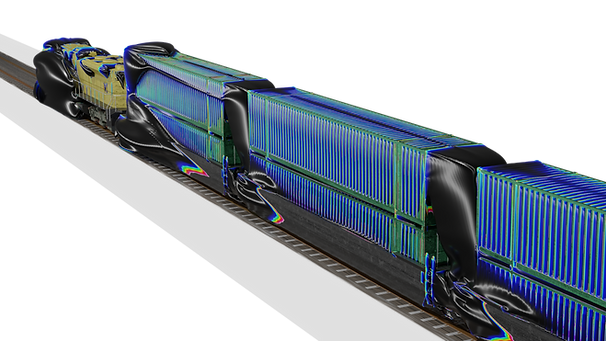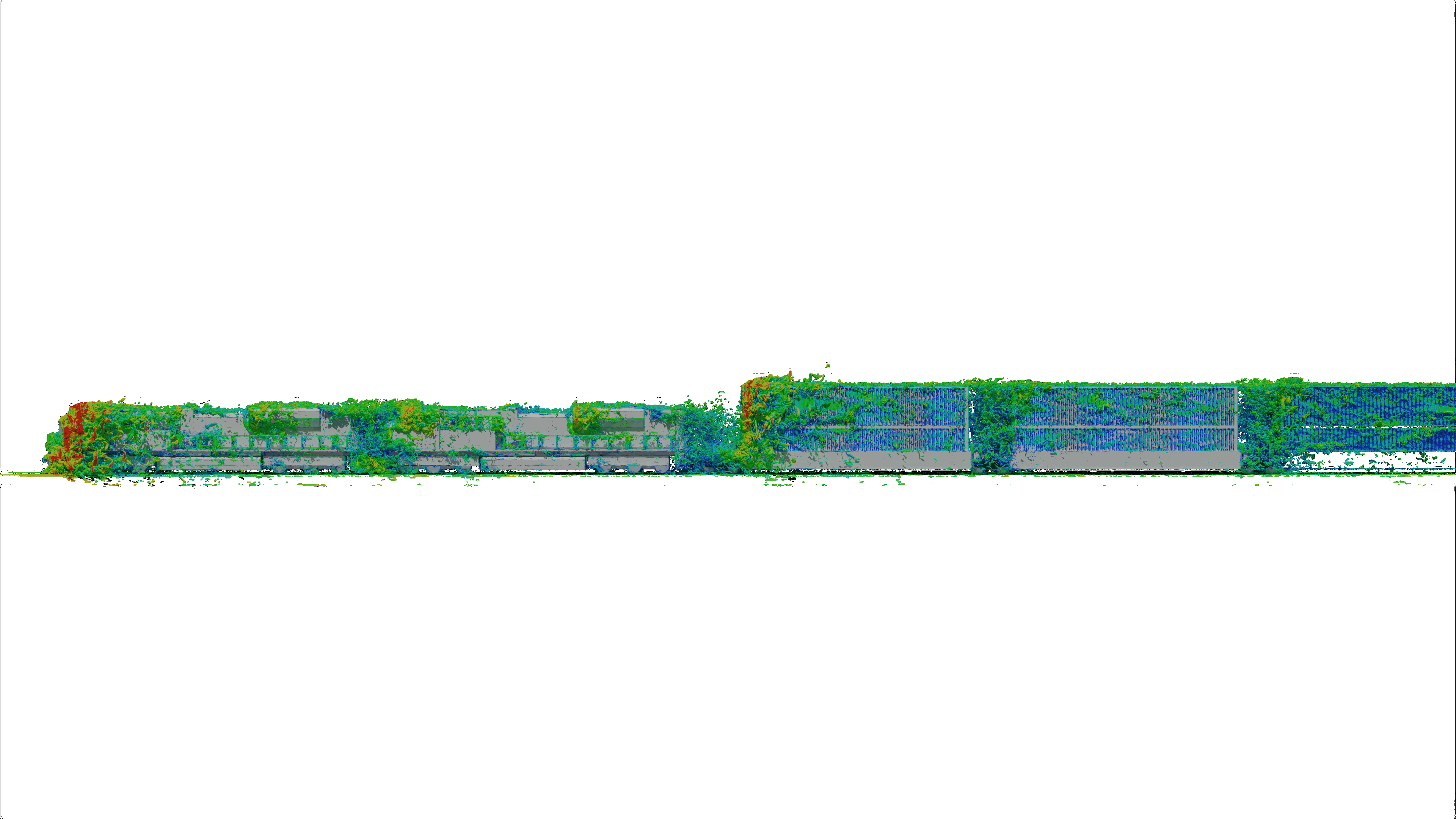At VFluid, we specialize in motorsport and high-performance vehicle aerodynamics. Deflect INC, on the other hand, specializes in designing and developing aerodynamic solutions for rail transport. By combining our capabilities, we create new solutions that enhance rail aerodynamic efficiency.
This collaboration is an example of how we at VFluid integrate with a client’s team, not just as external consultants but as long-term partners. Our approach is tailored to meet the client’s needs at every stage of the project, from concept development to final implementation.
Background
Deflect developed and patented an innovative aerodynamic device designed to reduce drag in the inter-car gaps between train cars.
Aerodynamic drag is one of the primary contributors to energy consumption on trains, often accounting for more than half of the total energy required for movement when a train is traveling at full speed. One of the most significant sources of drag in both passenger and freight trains is the inter-car gap, where airflow enters and strikes the front face of the trailing car, increasing the energy demand. Initial research demonstrated that Deflect’s patented aerodynamic deflector, the RoofRider, could mitigate this effect by directing airflow over the gap, thereby reducing the impact on the following car. This deflector, measuring less than an inch in height, is mounted on the roof adjacent to the inter-car gap using a simple adhesive application.
The early development of the RoofRider was carried out in collaboration with a university where Computational Fluid Dynamics (CFD) studies conducted on an ICE2 passenger train, supported by physical moving model scale testing, indicated that the RoofRider could provide significant drag reductions in passenger trains - a promising result.


Development & Challenges
Encouraged by the promising initial results, Deflect pursued further development of the RoofRider for passenger trains, partnering with VFluid Advanced Technologies to lead the next phase of aerodynamic optimization.
After extensive testing of different RoofRider configurations on various passenger trains, a significant issue emerged: the drag reduction observed in previous studies could not be replicated in our CFD simulations. Despite rigorous analysis, the expected performance gains failed to materialize.
To investigate further, a wind tunnel test was conducted at the Technical University of Berlin, a leading institution in train aerodynamics research. The findings confirmed the issue - earlier studies had provided an incomplete picture. They focused solely on drag reduction in the inter-car gap, neglecting the impact on overall aerodynamic drag. This oversight led to unrealistic performance expectations and ultimately resulted in time lost pursuing gains that were not achievable in real-world conditions.


What's Next?
The reality was clear: the RoofRider was not delivering the expected results for passenger trains. After all the time, effort, and resources invested, was it all for nothing?
At Deflect and VFluid, we believed otherwise. The concept had merit, it just needed the right application. That’s when we turned our focus to freight train aerodynamics.
At first glance, optimizing freight train aerodynamics might seem counterintuitive. Freight trains are inherently unaerodynamic, and they typically operate at relatively low speeds. However, the sheer number of miles they cover each year - particularly in the U.S. - combined with their lack of aerodynamic refinement, presented a major opportunity. Even small efficiency improvements could translate into substantial fuel savings over time.
But freight operators have two primary concerns: ease of operation and cost-effectiveness. Our new objective was clear - redesign the RoofRider to reduce aerodynamic drag on freight trains while ensuring seamless integration into operations and minimal maintenance requirements.

Freight Train Development
If inter-car gaps contributed to aerodynamic drag in passenger trains, the issue was even more pronounced in freight trains, where larger gaps are necessary for operational flexibility and each car body lacks aerodynamic refinement. The RoofRider had the potential to mitigate this drag.
However, making it work was far from simple. The deflector underwent extensive testing across various freight train models, configurations, and design iterations. The results showed an estimated 4% straight line drag reduction in intermodal trains before refinements to improve its effectiveness.

SideRider Development
With our client’s goal always in mind, we conducted an in-depth analysis of the flow structures around various freight trains. This led us to a new idea: what if, instead of placing the deflector on autoracks? This is how the SideRiders were born.
This approach proved highly effective, reducing the airflow entering the inter-car gap from the sides and lowering the high-pressure buildup on the front face of the following car. Additionally, moving the deflector to the sides provided greater design flexibility, as it was no longer constrained by height limitations.


Once the conceptual feasibility was established, we initiated an iterative CFD development loop, refining the design to maximize performance. While the CFD results were promising, we sought further validation through wind tunnel testing. Returning to the TU Berlin wind tunnel, we constructed a modular 1:20 scale autorack model, fully instrumented with force and pressure taps to gain deeper insights and directly compare our CFD simulations with experimental data.

The results were highly encouraging, not only did we achieve strong CFD-to-wind tunnel correlation, but we also reinforced our confidence in the CFD methodology, allowing us to proceed with the final development phase of the SideRider. The best performing deflector provided a CdA reduction in car 1 of -12.5% in the wind tunnel while our CFD simulations predicted a reduction of -13.2% at wind tunnel scale. These results validate our CFD simulations which predict a potential CdA reduction of -5% with the latest SideRider design at full scale and without holes in the Autorack side.

Final Development - The Porous SideRider
With the SideRider's performance validated through wind tunnel testing and good CFD correlation, we shifted our focus to full-scale CFD simulations of the Autorack under various configurations and operational states.
Through these in-depth simulations, we identified additional performance potential, leading to a key design evolution - the Porous SideRider. By introducing strategically placed perforations in the deflector, we retained the core benefits of the original design while mitigating certain drawbacks:
-
The SideRider continued to deflect high-energy airflow around the inter-car gap, preventing impingement and the associated high-pressure buildup on the front face of the trailing car.
-
The porous design allowed low-energy air from the near-wall wake to pass through and fill the inter-car gap. This resulted in higher base pressure in the gap, reducing drag on the rear face of the car and minimizing unwanted airflow from other areas, such as the underfloor and roof.

This innovative Porous SideRider design was submitted for a provisional patent and successfully enabled our client to achieve their key objective: a one-year ROI.
Conclusions
The development of the SideRider is a testament to the power of innovation, persistence, and collaboration.
What began as an effort to optimize passenger train aerodynamics evolved into a groundbreaking solution for freight train efficiency, demonstrating the importance of adaptability in engineering challenges.
At VFluid, we don’t just deliver aerodynamic solutions - we build strategic partnerships that drive real-world impact. Our collaboration with Deflect has shown that the key to success lies in continuous development, rigorous testing, and deep technical expertise. By working closely with our clients, understanding their challenges, and relentlessly pursuing the best possible outcome, we help them turn ambitious goals into measurable results.
This project underscores our commitment to providing cutting-edge aerodynamic innovations, ensuring that our clients not only meet but exceed their objectives. At VFluid, we push boundaries, refine ideas, and strive for excellence - because our clients’ success is our success.

Contact Us Today
Through continuous development, testing, and knowledge exchange, our long-term collaboration with Deflect has proven the value of strategic partnerships. This project exemplifies how we work tirelessly to help our clients achieve their goals, always prioritizing their best interests.
Get in touch with us now to explore how we can empower your project.



